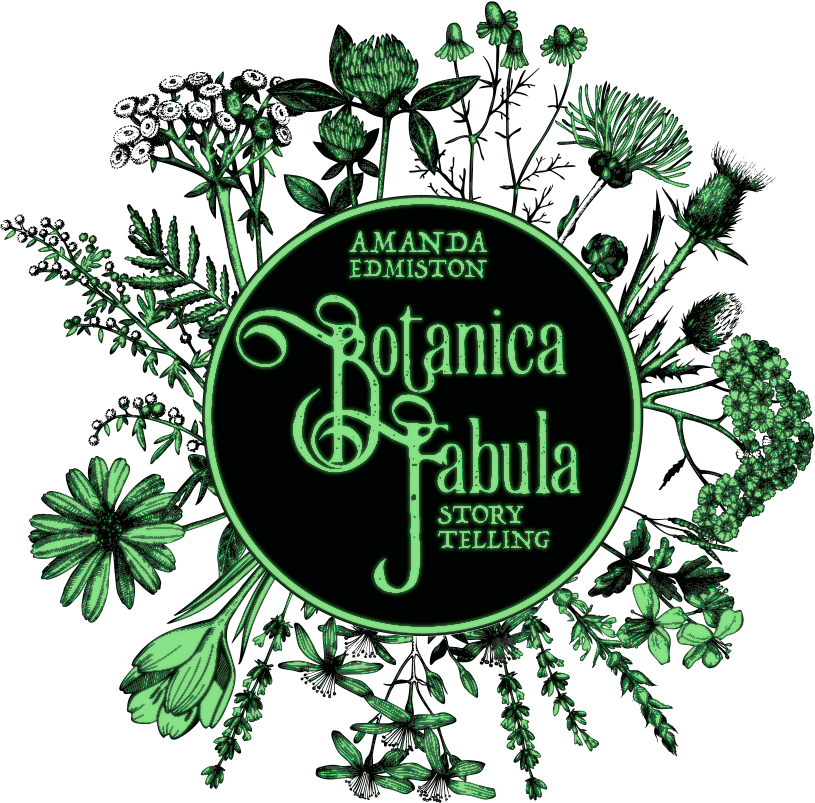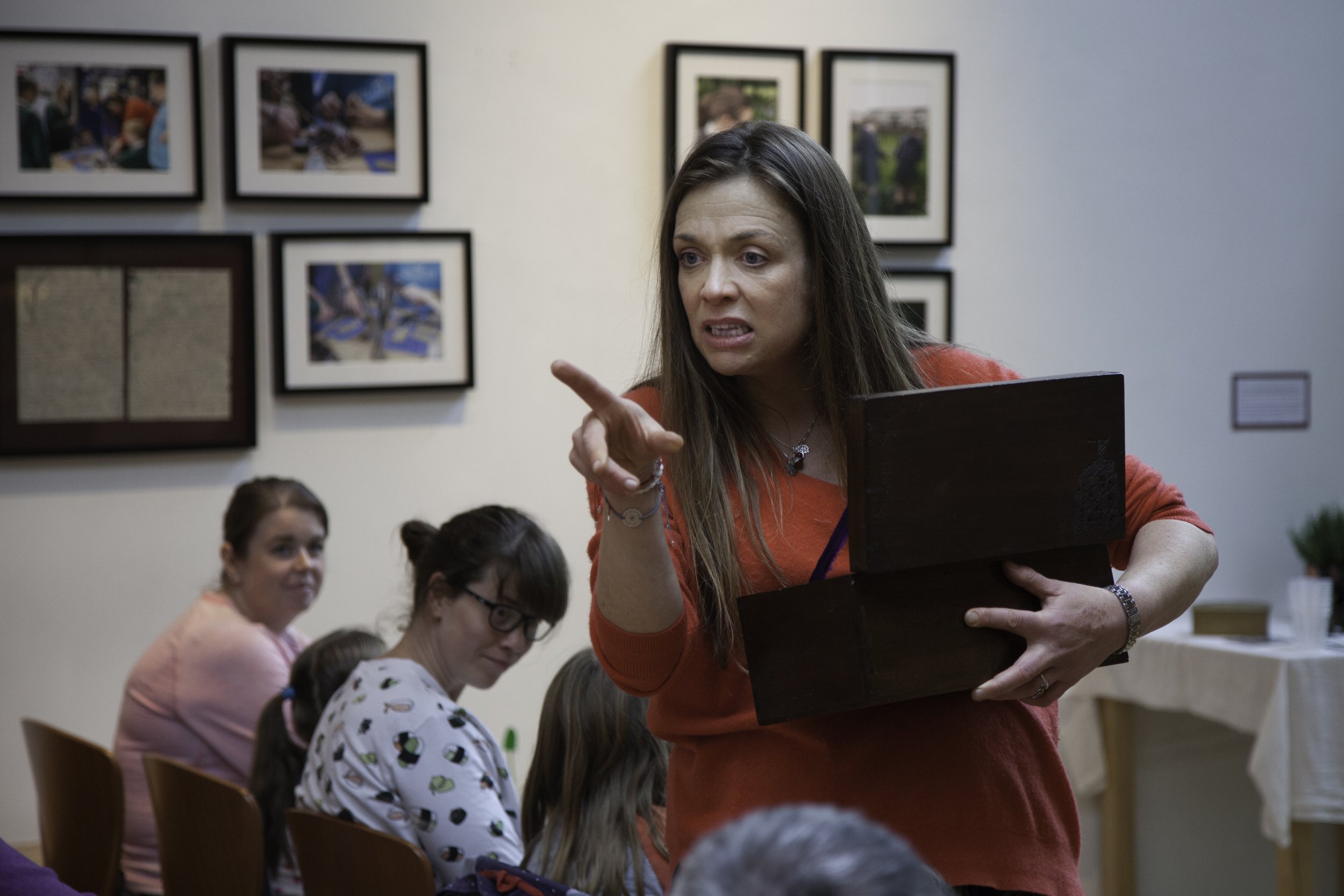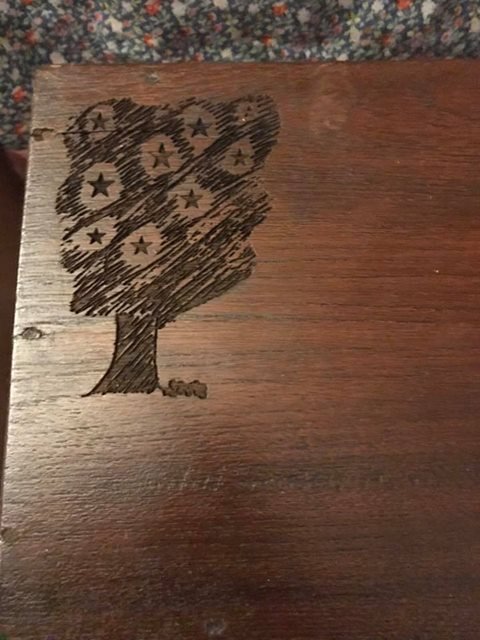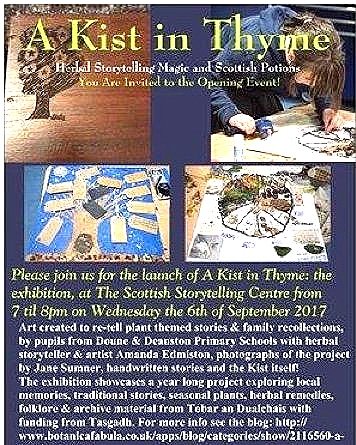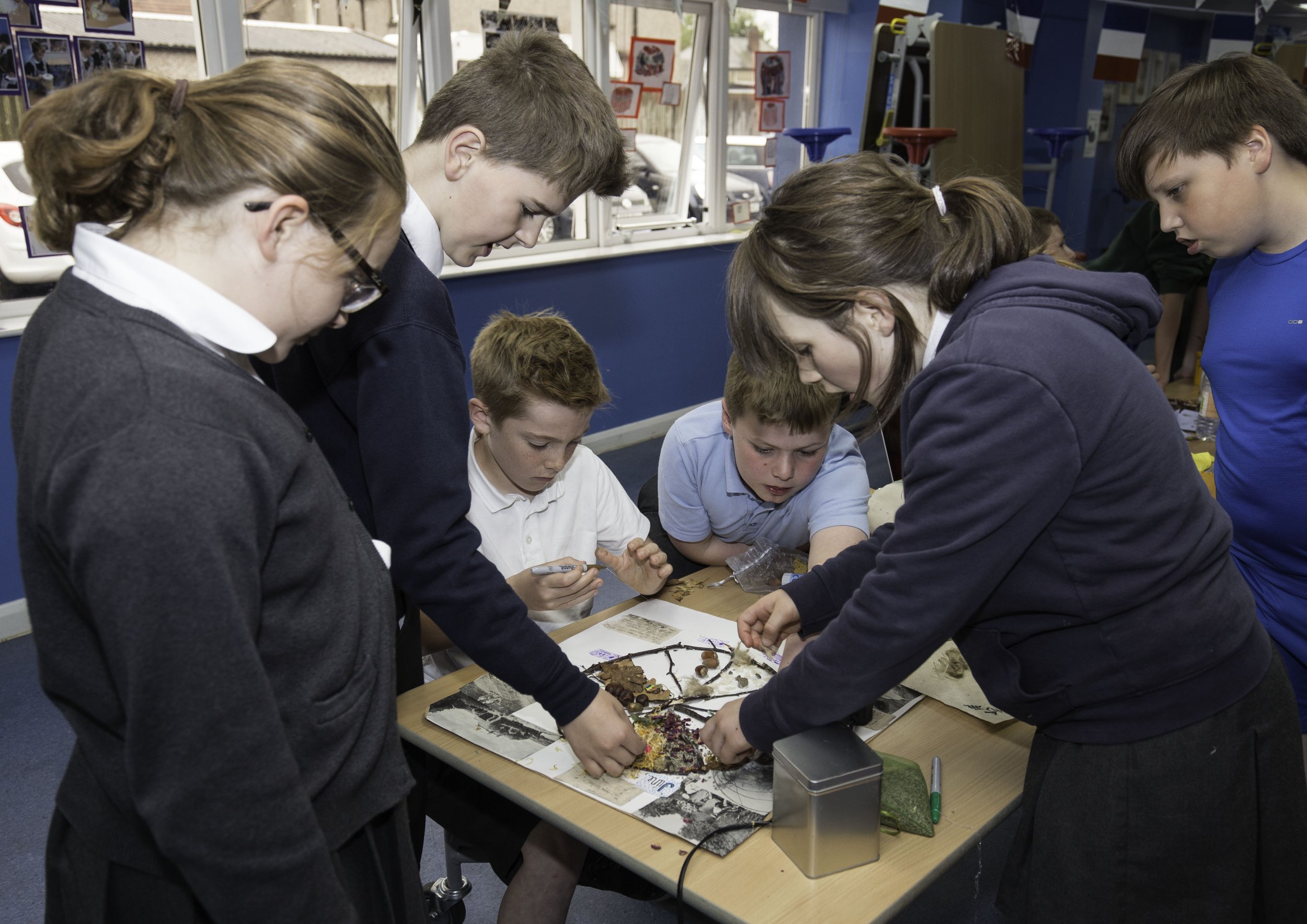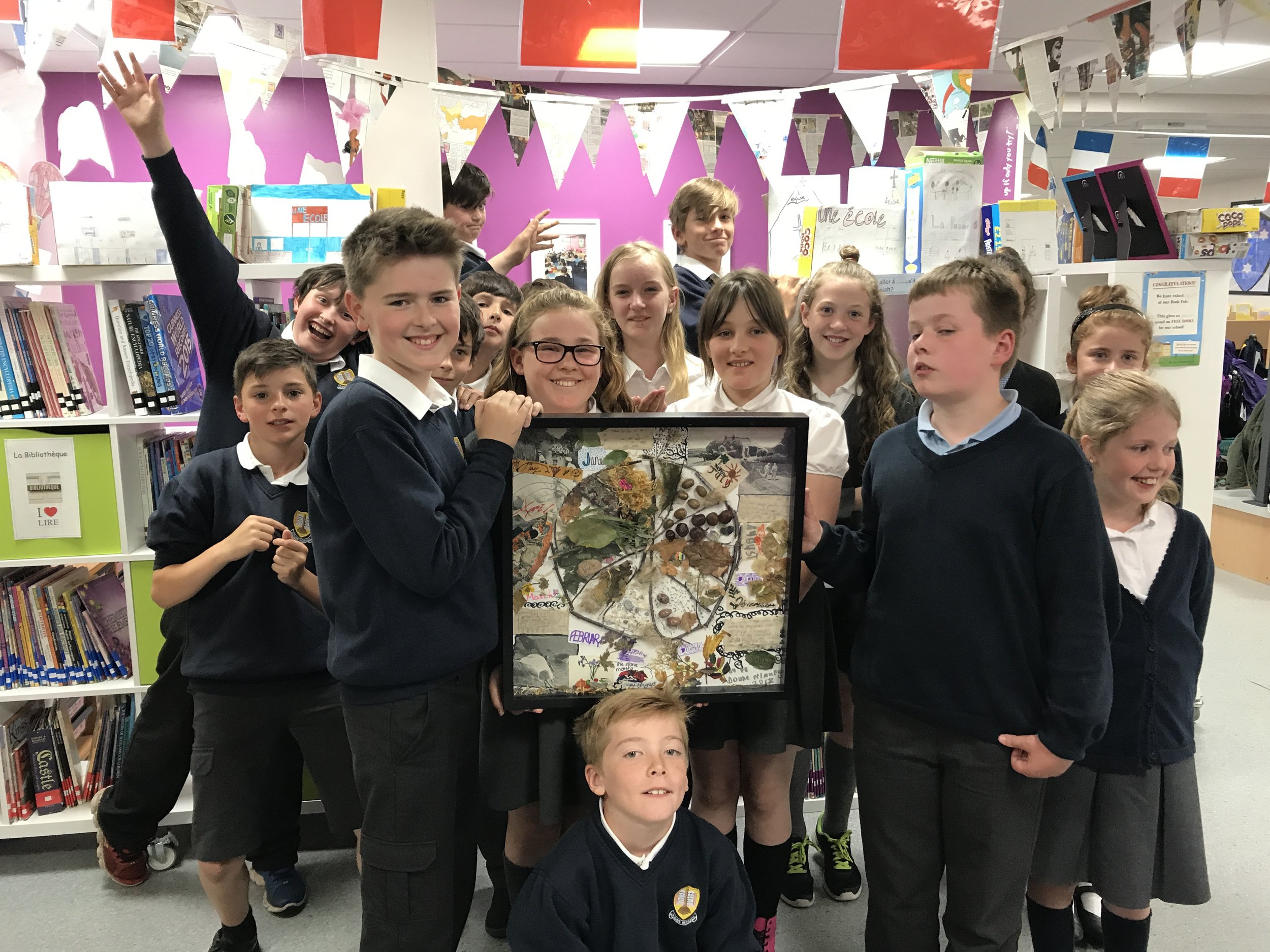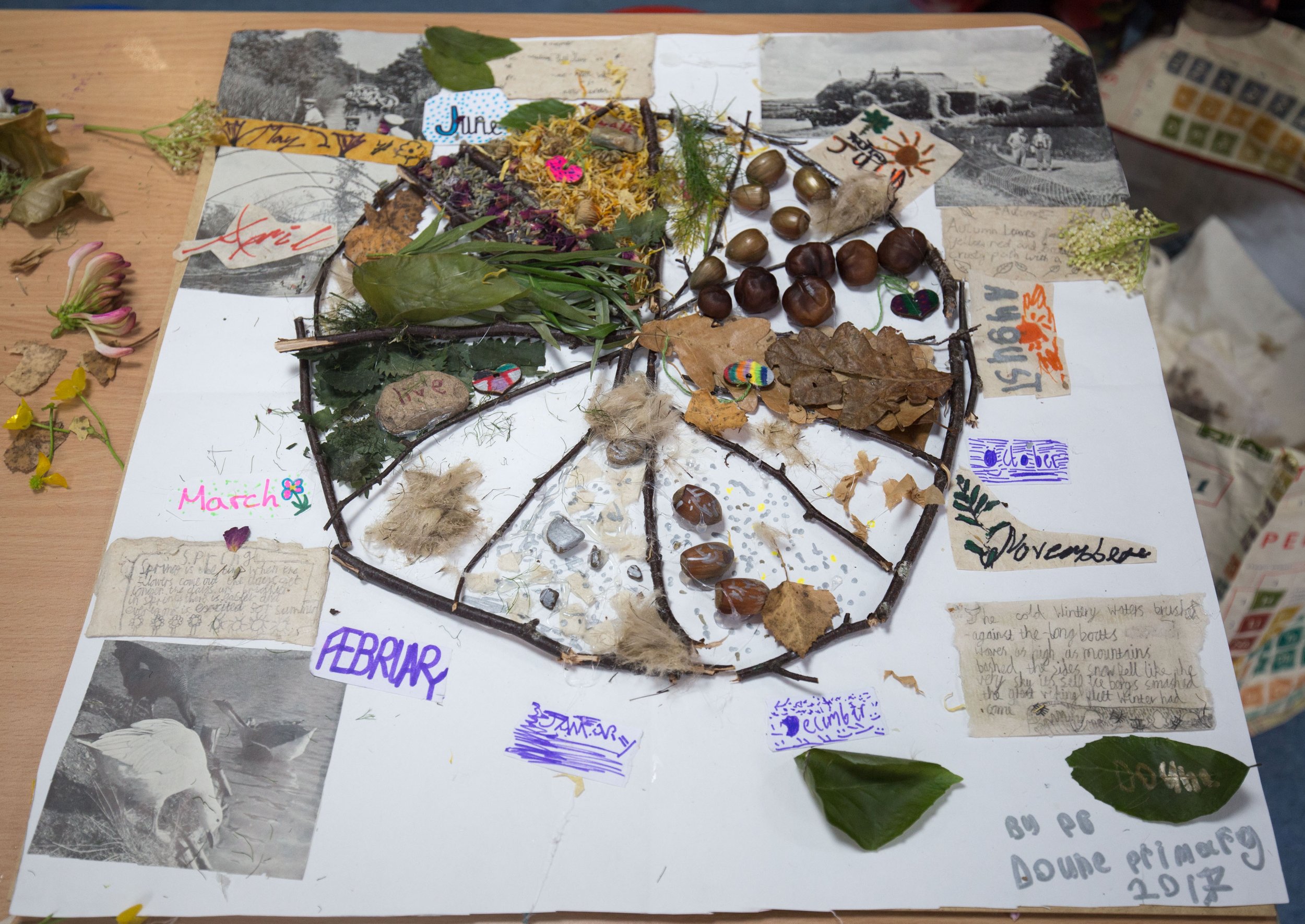The Kist in Thyme
The Kist in Thyme was a project created by Amanda over the course of several years. She worked initially with archive material from Tobar an Dualchais and memories shared by older people in rural Scotland. Then took the resulting herbal storytelling sessions to intergenerational groups and schools. Creating a series of storytelling led workshops and performance pieces which shared folkloric use of plants and rural traditions as they drifted out of living memory, weaving them into legends and fairy tales and keeping them alive and relevant for future generations.
The 2017 schools groups, then created artwork with Amanda in response to the workshops and the resulting work accompanied by photographs journaling the progress and the stories themselves became a touring exhibition with accompanying performances and workshops for audiences across the UK.
The Kist still informs a series of interactive performance pieces and workshops that Amanda shares and has a fabulous track record of getting everyone laughing, whilst also thinking about social history and changes to our relationship with plants that have occurred in the last 80 years.
The multi-dimensional, experiential Kist sessions have been loved by audiences at The National Museum of Rural Life, The Scottish Storytelling Centre in Edinburgh, The Ashmolean Museum in Oxford and The MacRobert Art Centre in Stirling amongst others.
New chapters to the Kist in Thyme have since been created, some online due to Covid restrictions that are available now as a Samhain themed online mini series of filmed workshops, with live, recorded sessions and invitations to add to the archive and create your own herbal kist to keep your family herbal memories alive for future generations.
You can catch some of the stories from the 2020 edition in this film Amanda made for The World Storytelling Cafe Stories from Amanda Edmiston
There is also a new Kist in Thyme style project: Story Spinning at the Old Mill in Killin in rural Perthshire which you will find on it’s own archive page.
A little taste of The Kist in Thyme: a look at traditional plant use in Scotland through art, stories, tastes and memories
“The Kist in Thyme exhibition is absolutely fantastic. Amanda's work has been really inspirational! Emma, PGDE student from Edinburgh University. From the launch of A Kist in Thyme, Scottish Storytelling Centre 2017
A Kist in Thyme for family audiences at The National Museum of Rural Life, Scotland. October 2018.
“I just wanted to thank you again for providing such a great activity for the day.
It was great for us to have something a bit different at our event and I was pleased to see how busy the theatre was when your performances were on”.
Nicki Bray, Learning Officer. National Museum of Rural Life.
Seasons, a little peek into a Kist in Thyme session
Seasons
It’s early Autumn and our hedges are covered in plump ruby red berries.
But a huge number of people are uncertain which is which!
They pause in front of the May, the faerie tree: Hawthorn and hesitate before asking 'Rowan?'
On a day to day basis identifying berries seldom comes up in many peoples conversations,
A lot of people correctly identify the big beauties of the British wild berry scene, the brambles and the rosehips.
But even then a surprisingly high number aren't confident enough with their I.D. to actually pick and eat them
I have veg box buying, kale munching, friends, who say:
" I would if I was with someone who knew what they were doing”
I know gardeners who assert that you can't eat domestic unsprayed rosehips…
Whilst I was delivering the first stage of the Kist in Thyme project in rural Stirlingshire, I found that the elders in the village at least, still mostly knew their stuff, but that younger generations were often uncertain and children particularly were unsure, having been cautioned against ‘poisonous berries’ they were wary and lacked the confidence I felt growing up in a rural area where having edible and inedible fruits and leaves pointed out to me by my mum and my gran was an everyday occurrence.
But what was a valuable reminder for me and I did notice with some of the older folk who
grew up just before or during the second world war was the vague residue of the association with wild food and poverty, we forget this in our age of trendy foraging, very quickly during my planning and research for Kist in Thyme I realised how our current perception of rural life, wild food, storytelling, herbal medicine is rose-tinted , we are now far enough away from the famine, disease and clearances that stretched into the 19th century for it not to mar our romantic view of recent rural history.
A class of 10-year old's grandparents grew up with the national health service and the benefits system .
The National Health Service was only introduced by Bevin in 1948 and I am very much a different generation, (this was after my mother was born) when I say this to a grown-up group I can see the moment of reflection as they pause and consider for a moment how recent this change in British lifestyle is.
Rickets due to vitamin D deficiency, lack of sunlight, poor nutrition is not a Victorian disease, it was still commonplace in the UK until the 1940s .
To omit these facts in an intergenerational sharing would be obtuse.
We are very lucky.
We may now covet a lifestyle filled with homemade hedgerow jelly, wild mushrooms and herbal tea.
But we have the luxury of choice.
We now know through societies omissions that previous generations hard work and shortages lead to wise ways and creative solutions.
But it’s about the flow and sharing of knowledge, it's about a respectful and aware acknowledgment of change...we should not seek 're-wilding' without being aware of the huge deprivation our ancestors faced that lead to them stepping away from natures harsh handed bounty.
Awareness is key, understanding, flexibility, respect and listening, equality must pervade intergenerational work, no one group is right or wrong, each has equal value and we must accept that there is value in our difference.
The class of 10 and 11-year-olds was studying farming, the class, their teacher and I were joined by a retired primary teacher whom I'd talked to at the local Heritage Society session.
The differences in how teachers approach talking to a class of children were immediately very evident for me!
I also realised how much I love a sense of dynamic energetic equal interaction between everyone in the room during my sessions and how although I see this as the way to learn, bouncing ideas off each other, creating, there is no wrong in creativity, there are morals and ethics and integrity, authenticity, hopes and dreams but there is no completely wrong, just elastic space to discover and experiment.But this session was interesting because the tight control a different generation of teachers had seen as the desirable norm, worked brilliantly with one or two members of the group who don't flourish as much as others when given an afternoon workshop with me.
Suddenly the different working ways were interesting and not as black and white as I'd expected.
It was also very interesting because my original community elders group were mostly locally born and bred, with the one incomer having moved from less than ten miles away over 50 years ago but now we were working with our retired teacher who had grown up in a very different part of the country, locality of plant growth became a major consideration.
She shared great memories of how rare a treat strawberries and other fresh berries had been in her childhood, we were looking at how the diverse selection of fruit and veg from around the world which now grace our supermarket shelves, very recent addition, but of course there is a huge local variation in the UK and Stirlingshire is pretty much part of Scottish berry country, close enough to 'The Berryfields of Blair' for locals to have once traveled the 40 miles for the harvest season. We listen to the song sung by Belle Stewart which chronicles the berry picking time.
We were drawn towards looking at sustainability again.
Handing round fat juicy strawberries from a nearby farm, now grown in polytunnels on raised shelves for easier picking and longer seasons we discussed the tactile sensory experience of picking strawbs whilst kneeling on straw with warm sunshine and friendly field mice....but considered that recently introduced methods are environmentally friendly, sustainable ways of increasing the crop size and lengthening the season.
I wove my new version of the classic story of The Twelve Months, shared so beautifully by Stanley Robertson on the oral archive I'm working with.
I told the group about Stanley's upbringing, how his grandfather had really, truly, run away to join the circus, about how the traveling people moved around the area to follow the seasonal work.
I embellished my version with subtle suggestions of ethics and points designed to draw the groups minds further into creative solutions to environmental sustainability and supply and demand.
In my retelling the first sister goes to find small quantities of unseasonal fruits to mend her sister's ailments and the second sister, maladies mended, goes to get huge amounts to sell in the market and gain wealth and riches.
The class quickly spotted the ideas I was weaving into the story.
We went outside...
There is a beautiful wild herb garden in the school grounds
We collaborated, made choices and designated tasks, three children volunteered themselves as 'good at maths', I gave them a ball of string and asked them to think about how they might divide the roughly circular pace into twelve months, when the string ran out the class problem solved finding them fallen sticks to mark the spaces.
We thought about what grew when, what foodstuffs people might have used before modern farming and transport expanded our choices.
I used Betsy White's brilliant recollections of foraged food and herbal cures from the archive to prepare for this stage of the project.
I wove Betsy's memories into stories as we worked, exploring the hedges within the school grounds, the children were interested in their potential to provide foodstuff . They talked eagerly about the opportunity to know what they could eat in the natural environment and how it might add a layer of possibility to games and adventures.
For the teachers they saw how it brought reality to modern classics of children's literature like Michelle Paver's 'Wolf Brother', or indeed Harry Potter, the potential herbal storytelling had for making literacy projects leap into life.
The class found armfuls of dry leaves for October
Bare branches for November.
The bleak months bear so little I tell a short story of winter and ‘the stone months’, we end up with pebbles representing the cold, seeds symbolising snow...I tell them about the old activity of children being sent to harvest thistledown to fill bedding...the seeds now also represent winter warmth, one girl remarks they would also be germinating under the soil during January and February.
We look at the berries in the school grounds, they can all now happily identify hawthorn and
Rowan and many try the hawthorn berries, they become September.
We had flowers...representing the summer months, three of the group chose their favourite colours for their birthdays, but we also thought they were rather appropriate as summer was so bountiful that it gave us time to appreciate flowers.
Nettles are grasped and their properties discussed, they are going through a phase at this point in September where they are re-growing in the Autumnal warmth as if we are experiencing a second Spring, the new tips become March.
Fennel seeds are guzzled...the Romans who once lived on this site were known to appreciate the seeds for their restorative powers, we imagine legionnaires eating them where we stand now.
Holly and Pine cones for December.
The teacher has clearly enjoyed herself hugely and remarked on how great it's been to sit within the class and watch them work and create things and process ideas and information....she says how 'great it is to have had an afternoon not teaching from the front’ and we've created a bit of environmental art, temporary but beautiful.
We go back indoors, the bell was about to ring, an afternoon has rarely passed so quickly.
I left them some books, a bit of a display, a few had been asking questions they could research for themselves tomorrow…
The follow-up sessions lead to the beautiful seasonal wheel,
